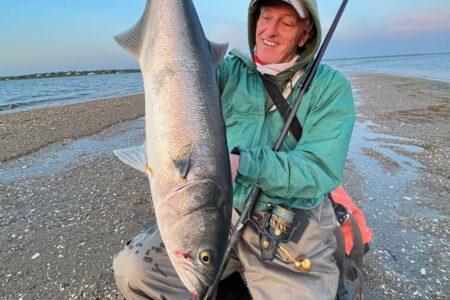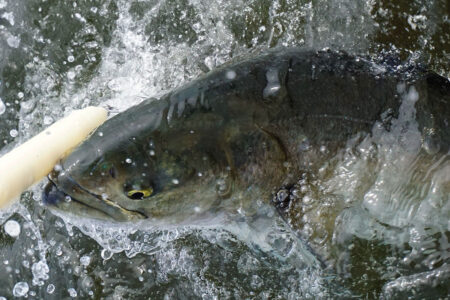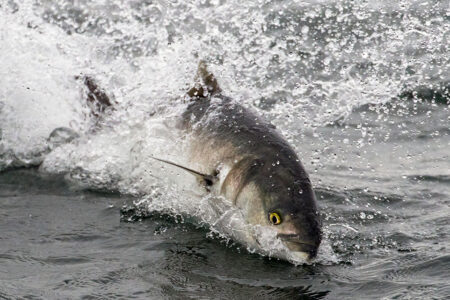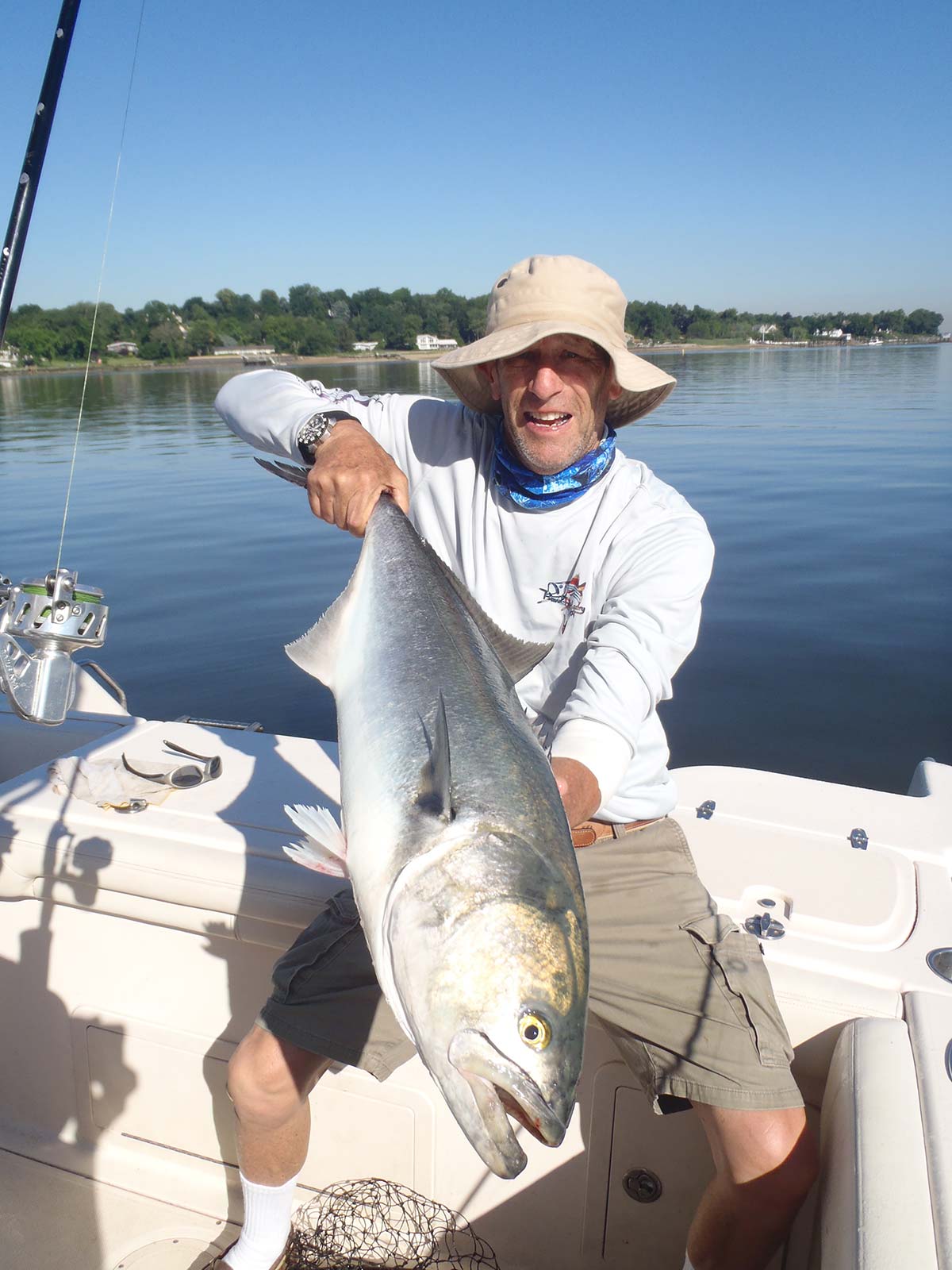
We caught blues that ranged from 9 to 16 pounds in our pursuit of daisy chaining choppers.
I enjoy memories about fishing experiences because they remind me of special outings; days and nights, as well as the people I enjoyed them with. The memories are diverse and include big fish caught, huge numbers, a blitz when I didn’t expect one, or laughing with friends and loved ones. There are also memories that evoke sadness. For example, a unique bluefish experience that was once reliable but hadn’t happened in so many years that the memory was fading from brilliant to a blur.
So, it has been, that each July for the last ten years or so Rich Lazar and I reminisced about past decades when large daisy chaining blues would quietly move about just under the surface of quiet shallow western Sound harbors. We almost always fished these blues alone, since other anglers shunned the experience, while we sought the big choppers aggressively. I wondered how many years without them was needed before all hope should be abandoned? Well, I believe that, for the most part, Rich and I had given up on them. Still, remembering those days of yore was something that we indulged in every year, saying to each other that this year they might be back. No smiles and laughter with this memory, just empty faces and a hope.
A 2022 Surprise
Then one day in early July 2022, while Rich slowly pushed his boat around the harbor searching for signs of the school stripers he’d been catching for the last few days, he spotted the blues. He told me that night that he thought for a moment he was seeing things, but the undulating tail fins told the truth of it. Now Rich, Marc, and I get excited about catching big blues no matter the venue or the technique, but Rich seems to have a special love of the beasts. I dropped all plans for the next day and arrived the next morning to see with my own eyes if it was true.
Two Signs
There are really only two signs to look for. First, as the blues swim in a pack one behind the other in a chain-like organization, they push water ahead creating a large v-shaped wake that’s easy to spot on the calm surface. However, that wake can be misleading, because fast moving bunker also leave a wake, and a sudden wind gust also may create a streak that looks like a wake. The next visual signs are the tips of the tails of the fish, and that seals the deal. These are not always easy to spot because a calm water surface also means glare. However, with a little practice an angler can spot the tips of the tails wagging along, one behind the other or side by side, as the school casually saunters along.
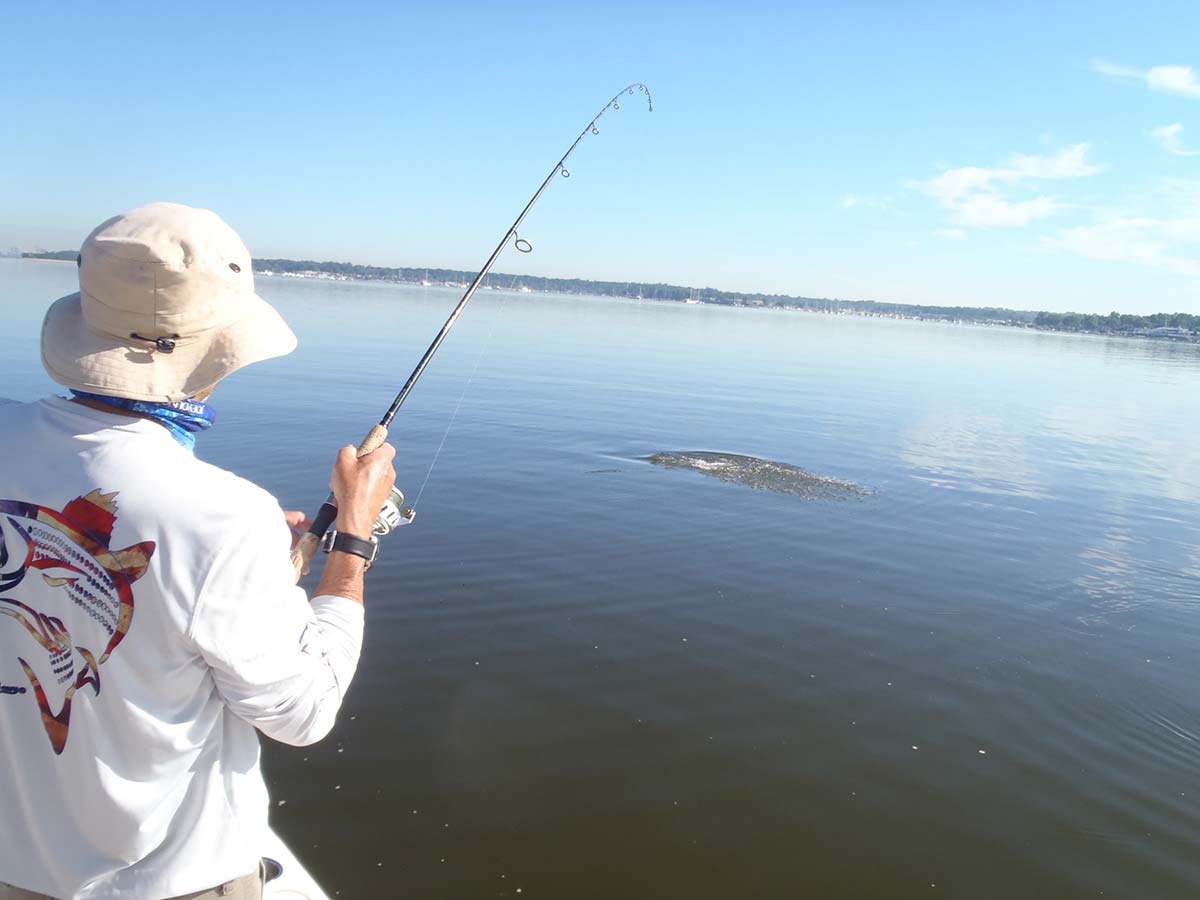
The Challenge
Beware, because at the moment of recognition there is a real temptation to gun the engine and get to the school and start fishing. However, that’s the worst thing you can do. The blues will scatter as soon as the engine revs up, even if the boat is a thousand feet away. Instead, Rich nudges the engine out of neutral into gear and we plod with agonizing slowness toward the blues. I use the word “agonizingly” because any angler worth his or her salt will be itching to catch one of the brutes, but in this scenario, patience wins out over enthusiasm every time. Rich is careful not to get too close to the school because that will scatter them, too. That means he puts the engine in neutral quite a distance away from the school and allows the boat to glide toward the school. We’ve found that an idling four-cycle engine that produces constant but low-level noise doesn’t spook the fish.
| WHAT IS DAISY CHAINING? |
| Bluefish aren’t the only species to daisy chain, but the list isn’t long either, and it’s the only fish we’ve found doing it in shallow harbors. But what is daisy chaining? The phenomena occurs when it’s slick calm, the water temperatures are in the 60s or low 70s, and there is no boat traffic. Although it can happen at any stage of the tide and any time of day, we’ve found that the last three hours of the ebb tide seems to be the most reliable. |
Again, patience is the watchword. We both know that we’ll need to make long casts and we’ll need to hook up quickly. So, holding back on the cast until you can reach the fish is taxing on the twitch muscles. Even a cast that doesn’t reach the fish sometimes spooks them. Frankly, as the boat glides it is the time when I must use every ounce of personal discipline not to cast. I also know that the first of us that hooks up might be the only one to hook up, while the other angler watches tail-tips disappear and fish scatter in all directions.
Chain Tackling Tackle
Daisy chaining blues offer a great light tackle opportunity since the water is shallow and calm, and the lures are light. Rich, Marc, and I use different tackle combinations, but they all have one thing in common: they’re light but powerful. Take the rod I use. It’s a 7-foot Shimano Teramar that is rated at medium power, but with a fast tip that allows me to cast relatively light lures far and reach out to those wary blues. I match the rod to a Van Staal 150 spinning reel engineered to provide superior cranking power that makes even big blues surrender more quickly. Remember, the water is warm in the shallow harbors in early summer and, unless the fish are subdued quickly, bluefish will wear themselves out on other light tackle, making their survival after release more questionable.
I spool the reel with 20-pound test Sufix Performance Braid and add a 30-pound test Perlon leader at the terminal end to accept the lure. With 20-pound test line, a strong leader, and a powerful but light rod and reel combination, I don’t hesitate to put heat on the fish and bring them to the boat as quickly as possible. With this tackle and a well-tied improved clinch knot I can easily use five pounds of drag pressure. That doesn’t sound like a lot of drag, but it is. Try this out in a yard or field. Tie a rope around a tree and then slip the hook of a scale over the rope. Then, affix the handle end of the scale to your leader. As someone pulls back on the rod and slowly tightens the drag, you can watch the scale. When it reads five pounds, look at the bend in the rod. Then reverse positions with your assistant so that you can feel how much force is involved with a five-pound drag. You might believe the line will break, but with a well-tied knot that shouldn’t happen to 20-pound test line and a 30-pound test leader.
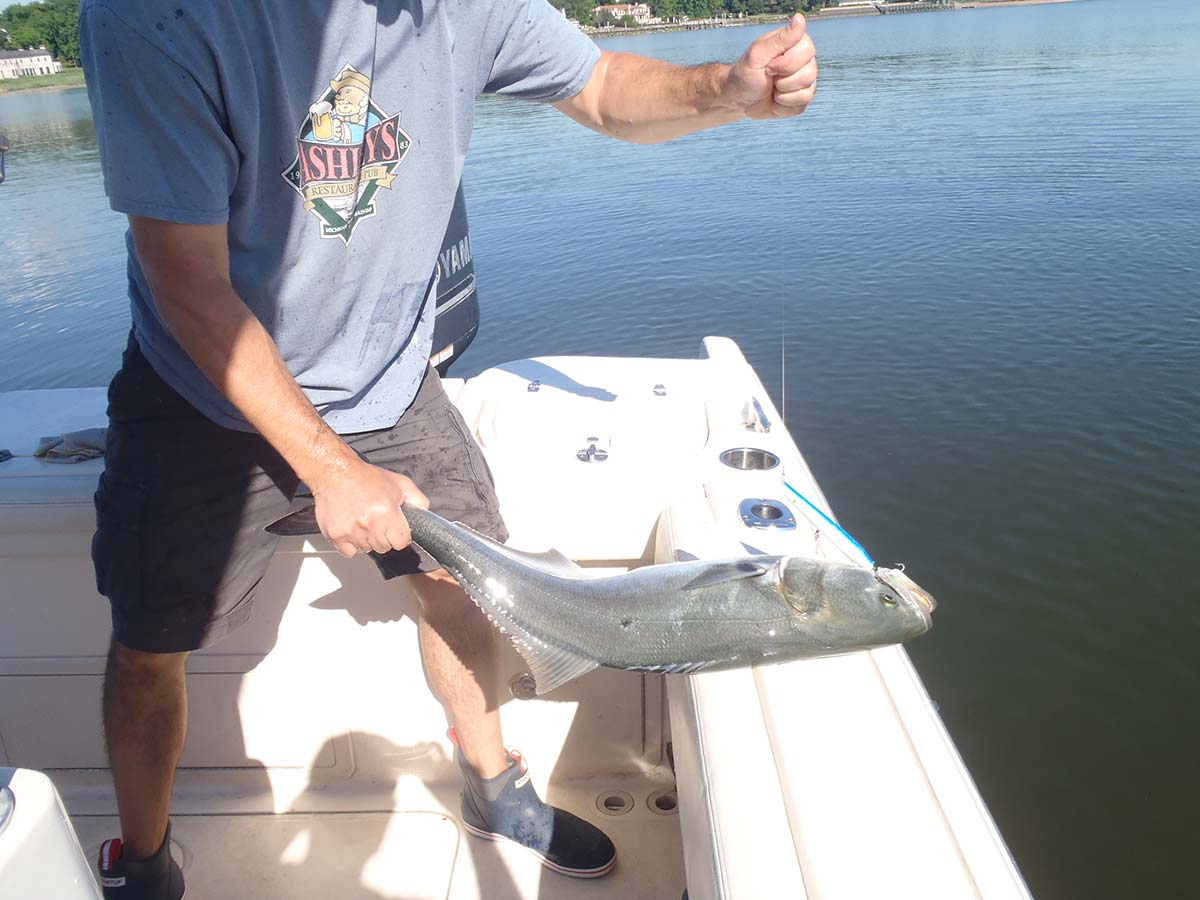
Best Bluefish Picks
There’s no need to bring along a huge selection of lures for this outing. You’ll only need a few styles. I use 1-ounce Cotton Cordell pencil poppers, 1-1/2-ounce Super Strike Little Neck Poppers, 3/4 and 1-ounce white bucktails, and a few pearl-colored 5-inch Z-Man Diesel Minnows on 3/4 and 1-ounce leadheads. I like the Z-Man paddle tails because they are made of a stretchy plastic that stands up to bluefish teeth quite well. Whereas most paddletail plastic is chopped with one bite, I usually catch several big blues with just one of them.
The Single Advantage
| PENCIL MAGIC |
| Some days the pencil popper is the best lure. If they hit and miss, they’ll follow and try again, while with sub-surface lures they rarely do. Possibly due to it’s the surface commotion and the noise that keeps them interested. However, on days when they are less wary and more eager, the author sticks with the white bucktails tipped with a 4 or 5-inch pork rind. He prefers red rind, but white or yellow is good too. |
One advantage of single hook lures is how easily the blues can be wrangled at boat-side. Since we release the blues, we don’t usually use nets to land them because it removes protective slime from their bodies. When blues are lightly hooked, we try to remove hooks while they are still in the water. A Boga Grip helps to subdue the blues in the water at boat-side. Single hooks are safer, while two sets of treble hooks and the never stop fighting attitude of bluefish is a tough combination that works against easy hook removal. An angler may remove one hook, the fish thrashes, and in the process puts another hook or two into their body; hopefully not the angler. Bucktails and leadheads are much easier to remove, are less dangerous to both bluefish and anglers, and since the process is quicker, the angler gets back into the action faster.
What To Do Next
We can pretty much count on the scattering of the school after one or two fish are hooked, although there have been days when the fish stayed close and continued to hit our lures for multiple hook-ups. But, don’t count on it. That begs the question, what do we do now? The good news is they don’t leave the harbor or even swim a half-mile away. Instead, most times they scatter and move off a few hundred yards where they school up again quickly and begin daisy chaining again.
Obviously, finding them again should a breeze pick up limits the chances considerably, although it is possible for a sharp eye to spot a tail among the ripples or note water movement opposite to the breeze. If the weather remains calm, as it often does on late June and early July mornings, you’ll be able to spot the tail tips within five minutes or so. Simply repeat the original quest. That is, move quietly and slowly, drift on and off in neutral, and resist the temptation to get on the fish quickly, and it’s possible to enjoy a number of encounters before the tide dies.
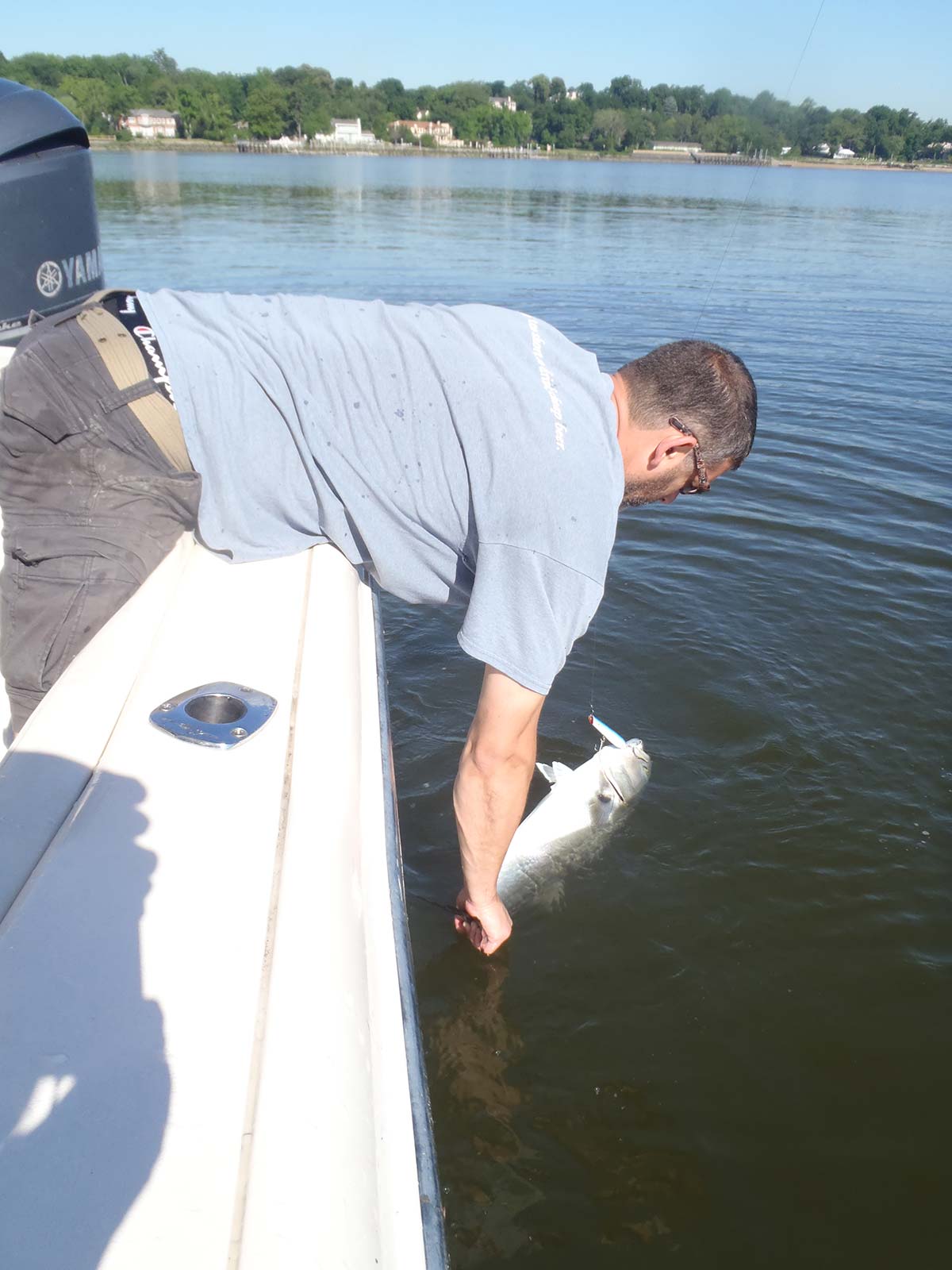
Never Be A Snob
I’ll never understand why any fisherman would stick up their nose to big bluefish. Blues aren’t polite ladies and gentlemen. Instead, they are relentless fighters, much stronger than most other gamefish of the same size, and test the mettle of our tackle. They also jump, dive, make long fast runs, and get off hooks regularly. I will admit that I walk away from small bluefish. They lack the stamina and strength of their older siblings, but not the nasty attitude. They come in green, bleed from the mouth, and throw blood all over me. No, not interested in the little guys.
We hooked a lot of fish, dropped a lot of fish, our tackle took a beating, we wrangled the big bruisers successfully without anyone being bitten or a hook thrust into a hand. We caught blues that ranged from 9 to 16 pounds in our pursuit of daisy chaining choppers that day, and they hung around for a week. I’ll sign up for that any day of the week and twice on Sunday.

